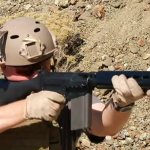MAN vs GUN – Primer
- By tire iron
- 4 February, 2015
- No Comments
MAN vs GUN – Primer
There are plenty of sources of information that discuss in detail the features and benefits of nearly every rifle in use in the world today. Barrel length, twist rate, velocity, coatings, plating, etc, etc, etc.
What is missing from all these discussions is how well these rifles fit and work with the human body. My experience is that some rifles work with the human body better than others. No rifle is perfect, yet. We are getting closer though. Designers actually trying to design rifles that work better with the human body. With that in mind, we are going to test a variety of rifles against a set of “standards” (strings of fire) and using that data to come up with a chart that shows which rifles work better with the body than others.
Foundation:
#1 – Fighting Rifles must be RELIABLE. They must go bang if there is a round in the chamber under adverse conditions.
The magazine must be equally reliable, it must feed ammo into the chamber under adverse conditions.
#2 – Fighting Rifles must be DURABLE. They must be able to withstand hard use and still keep running.
#3 – Fighting Rifles must be intrinsically ACCURATE (enough). They should keep all rounds on a pie plate size target out to 200 meters. This is determined by bench resting the rifle. Obviously, more accuracy is better as long as functional reliability is not adversely affected.
#4 – Fighting Rifles should be as ergonomic (and mirror image) as possible. How well the rifle works with or works against our bodies movements will determine how fast we can get good hits, and how fast we can operate the controls and clear malfunctions.
For armed citizens I also add #5 – which is REPAIRABILITY. Can you get parts, and can you fix your rifles when (not IF) a part breaks or wears out?
The “MAN vs GUN” series will document how different rifles do based on #4 above – we will see how well different rifles work with or work against the human body and how we operate long arms.
This series will not check #1, #2 , #3 or #5.
Purpose
ONLY HITS COUNT. With that in mind, some rifle designs are better than others when it comes to allowing good, fast, accurate hits. The below drills will allow us to build a data-base of how differing rifles compare to each other when it comes to getting good hits the fastest.
NOTE: Ultimately it is the person SHOOTING the rifle, not the rifle that will determine the outcome of a gunfight. If you keep building upon your Warrior Triad (skills, mindset, tactics) it won’t really matter which tool you have in your hands. On the other hand, if you don’t work on your Warrior Triad, you could have the rifle that gives the best chance of a good, fast hit, but you will still lose.
Then again, the one with the strongest Warrior Triad using a tool that is; easy to get good, fast hits; to quickly and easily clear malfunctions; is controllable with multiple rounds on a single target; or dealing with multiple targets, will have an obvious advantage.
What handling characteristics do we want in our rifle?
To be able to get accurate, fast snap shots.
To be able to clear malfunctions quickly and easily.
To be able to reload quickly.
To be able to transition from shoulder to shoulder and get good hits from each shoulder.
To be very controllable when shooting many rounds, fast.
To be able to swing from target to target, in high speed, close range type scenarios.
Man vs Gun Course of Fire:
Head Shots from low ready, safety on, at 25 yards. Perform 5 times.
- Checks balance for snap shots – how well the rifle works with the man to ensure a good, accurate first hit on a small target. Balance or “feel” plays a role here.
- 5 shots total (1 each string)
Speed Loads with body hit at 25 yards. Perform 5 times. Start with round in chamber, and empty mag in rifle. Safety off, muzzle at target. At beep, fire one round, if you can feel the bolt hold open, immediately change mags. If the rifle doesn’t have a bolt hold open, attempt to fire again. At the click, immediately reload and fire one shot at the body at 25 yards.
- If the bolt holds open is it really faster than if it doesn’t? If it is faster, by how much?
- 10 shots total (2 each string – one before the reload, one after)
Type 1 malfunction clearance drill with body hit at 25 yards. Perform 5 times. Safety off, muzzle on target. At beep, attempt to fire, then clear malf and get body hit at 25 yards.
- How well is the rifle engineered regarding Tap-Rack-Bang. Is it faster than other designs when it comes to clearing a Type 1 malf?
- 5 shots total (1 each string)
Type 3 (double feed) in the PRONE position – this is the worst position for having a double feed. Rifle starts with double feed set-up. At beep, an attempt will be made to fire, then clear the malf and get a body shot at 25 yards. Mags will be out of mag pouches laying on ground to negate any “gear wrestling” that may skew the times. Perform 5 times right side and 5 times left side.
- How well is the rifle engineered to deal with this problem in the prone? Some rifles are a real chore to work in the prone, some are less so. Let’s quantify which is which.
- 5 shots total (1 each string)
Shoulder Transitions – Safety off, muzzle on target, at beep shoot one body shot at 25 yards, switch shoulders and shoot one body shot at 25 yards from the other shoulder. Perform 5 times.
- 10 shots total
- Remember this is 50% right side cover in the world and 50% left side, so we need to be proficient at switching shoulders. Is one design better than other when it comes to switching shoulders?
10 shots at 5 yards (into paper plate size target) Safety on, low ready. At beep shoot 10 shots into paper plate target at 5 yards. Any shots off the plate are a miss.
- This checks controllability of the rifle for multiple shots in succession. We want to get all 10 shots in the zone in under 2.5 seconds.
- 10 shots total (perform one time)
1-2-1-3-1-4-1-5-1-4-1-3-1-2-1 – 5 yards. Safety on, low ready. At beep shoot the targets in the following manner, one shot each. 1-2-1-3-1-4-1-5-1-4-1-3-1-2-1
- This checks how “lively” the rifle is at swinging between targets at close range and high speed. Gunfights typically have more than one bad guy. Being able to go from target to target quickly and accurately is an important skill. Which rifle will help you the best?
- 15 rounds total (perform 1 time)
Man vs Gun Methodology:
Each string of fire will be timed, scored and recorded.
Master record (Google Sheets) will be kept on my here on my blog – CLICK HERE TO VIEW SPREADSHEET.
Video evidence of each will be kept on my youtube channel.
I will fire all rounds (that keeps the variables to a minimum as it will eliminate differing skill level).
Man vs Gun Round Count:
These are fixed round count strings of fire. You need to go as fast as you can and still get a good hit/s. Misses cannot be made up with additional shots.
Total round count is 65 rounds.
Check out the video located here!
Man vs Gun Rifles:
The below represent the rifles I plan on running through the above course and that I have access to:
OEM (no mods)
Bone Stock AKM (Romanian)
Bone Stock M4 (iron sights)
Bone Stock M4 (with EOTech)
Bone Stock FN FAL (16”)
Bone Stock AR308 (S&W M&P10)
Bone Stock Tavor
Bone Stock SCAR-H
Bone Stock SCAR-L
Bone Stock FN FNC
Modified
My “go to” M4 (with Vortex 1-4)
My “go to” M4 (with Aimpoint T1)
My “go to” AKM (with iron sights)
My “go to” AKM (with Aimpoint T1)
My “go to” AK74 (with iron sights)
My “go to” AK74 (with Vortex 1-4)
SKS 16” with Tapco stock and 20 round magazines
Man vs Gun Rifles I would like to test but don’t currently have access to:
Bone Stock AK47 (milled variety – I want to see the performance difference vs bone stock AKM stamped receiver)
Steyr AUG
FN2000
Ruger Mini-14
HK91
HK93
HK G36
SKS (Bone Stock with 20” barrel)
M1A
M1 Carbine
M1 Garand
What would you guys like to see?
If you have a rifle that you would like me to put through this test, I can arrange for my dealer to accept it and return it to you after I am done videoing the test.
My dealer is North Western Guns and Ammo located in Ogden, UT. You can send your rifle directly to him, and after we put it through its paces he will send it right back to you. You just pay shipping one way – I will pay for return shipping.


 Copyright © 2024
Copyright © 2024
Leave a Reply